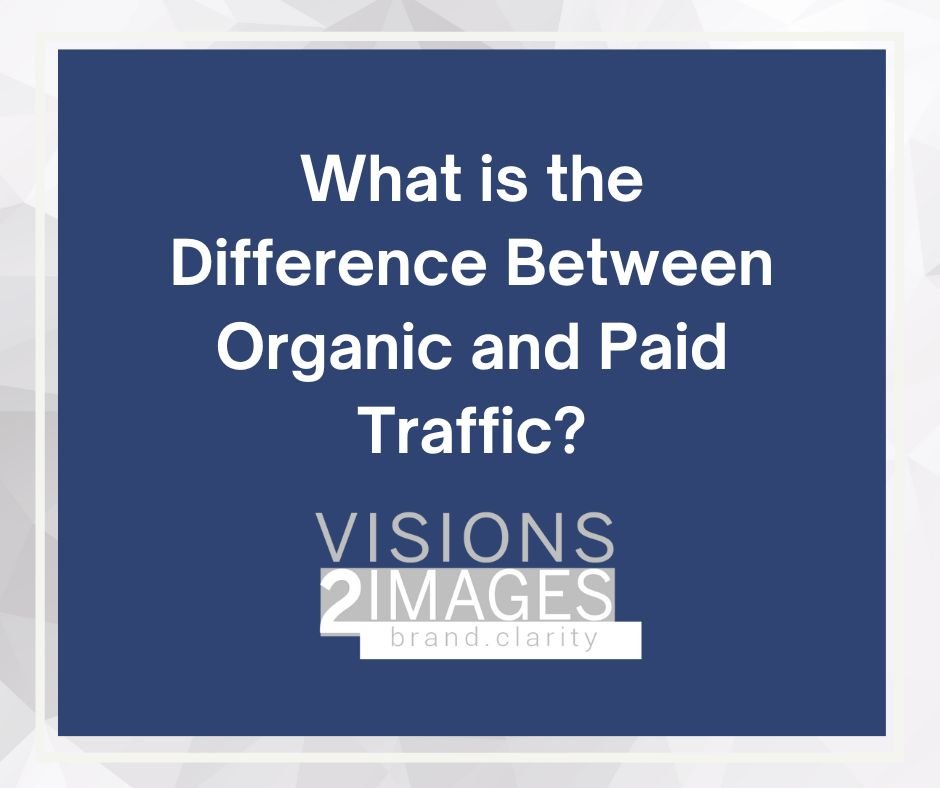
What is the Difference Between Organic and Paid Traffic?
It’s important to understand the difference between organic and paid traffic so you can use them to your advantage. Listen to the podcast here. A lot of times, people don’t understand the difference between organic marketing and paid advertising.
I hear it often: “Oh, I’m posting on social media. I’m doing all of these thingsI” always recommend posting on social media and doing all the marketing tactics, but to grow your business, we have to do paid advertising. There’s just no way around it.
Organic marketing is unpaid social media posts or any posts you do on social media that you do not pay for.
This can be on Facebook, Twitter, Snapchat, Pinterest, TikTok, and LinkedIn. Other forms of organic posts can help, such as blog posts, email newsletters, SEO, publicity, link generation, and YouTube. So there are all these different components of organic traffic and how to get it.
Paid advertising is when you pay for ads. It seems simple enough, but there’s so much more. There are paid social ads, sponsored ads, display ads, video ads, and YouTube ads. With advertising, you can fine-tune your audience and who you want to reach. You can do paid advertising on Google, LinkedIn, Facebook, Instagram, Pinterest, etc.
Organic Marketing:
1. The first thing that you need to understand is your audience. Organic and paid will not work if you don’t understand your audience. That’s just the nature of the game. You have to understand the ‘where, when, how, why, where of how they are shopping. What are they doing? How do they discover your business? Where are they coming from? Are they coming from social media? Are they coming from your website? Are they coming from Google My business? Where are they coming from? It’s not just single moms in their thirties. It’s beyond that. What are they doing? How much are they spending? All of these things really can help with organic and paid traffic.
2. How can you show up in the best way, both organically and in paid advertising? This is what we do in the initial conversations we discover, who is your audience? How can we build this? It’s a consultation where we go through all of these steps of who the audience is, especially with franchises. We understand what you have tried in the past and what your goals are. Sometimes people say, I want to sell more franchises. But, who do you want to sell more franchises to? Where do they live? What’s their education? What’s their background? How much does a franchise cost to buy into? All of these components and more matter, no matter what business you have
3. You will want to create content for both organic and paid marketing. If you want to focus on organic traffic for your blog, you’ll need to do keyword research, and competitor analysis, and consider what do we want them to do on our call to action? How can we use this blog post to target more people? You’ll have to do that research, and you’ll have to know what platforms to post on beyond your website. For example, do you want to do paid Google ads? There are different components to doing a blog; it’s more than just posting content. We cannot just post it and say ‘they’re going to come to us.
4. You will want to optimize your content. SEO is critical. There’s so much to SEO that it’s not just ‘a one-and-done’. You have to build, and keep building constantly. And the fun thing about SEO is even if you’re only posting on Facebook, make sure you’re posting the right content because Google uses it. If you search a business, you will find their Facebook page, website page, and social platforms, if they’re doing good marketing. It’s always important to use the keywords repeatedly on all platforms. More importantly, you might want to optimize your blog post, video posts, and social media posts.
5. Each social platform is obviously different. YouTube is a great example. I recently consulted on a client’s YouTube channel. I showed them how to optimize it and get keywords included. For example, we can’t post a customer testimonial in the description. The description matters. What does that mean? Who is this for? What is the outcome? What is this video about, what are keywords that people would be searching for? All of these factors play over and over again; even the title matters more so on YouTube than anywhere else. You want to have keywords on your image because it’s a factor that goes into Google. We must consider if there’s a competitor and what they are posting. What are the keywords they are using? So really optimizing it and doing that research is critical for any company.
Those are just some great examples of how organic marketing can work for you. However, when you put paid advertising and organic marketing together it creates amazing results. Read below.
Paid Advertising:
1. What are the keywords? What are they searching for? It’s just a process that repeats. That is why people hire marketing agencies because you need an expert to do these things. Sometimes you might be able to do it and get away with it, but if it’s an ongoing thing we have to adapt and change. What worked two months ago might not work now; the keywords might have changed. There’s always so much that has to be done in marketing. And that’s why having an agency to come in and help discover these things and always change and adapt these things for you is so important.
2. We always have to set a budget for how much we want to spend. We also want to know what is the goal? In organic content, we might say the goal is to click to learn more or schedule a call. The goal for paid advertising is slightly different. We are going to define what your audience would want to do. Let me give you an example. I work with an e-commerce shop, but they also have a brick-and-mortar shop in their location in Pennsylvania. And they want to bring customers into the store. So we are always saying, call now, because we want them to call for that shop. We don’t want them to go to the website. We want them to call to book an appointment. When we do paid advertising, it is so specific, and we want them to call us that we have to focus on that call to action and that goal; we niche down into the people in the surrounding areas. So we want to make sure that it’s that area that we’re targeting is correct, that it is not the whole United States.
3. I don’t do the same ads all the time. I change ads. I change audiences. I change things constantly for people; even in organic posts, we want to ensure that we’re not posting the same thing all the time.
4. Make sure that you’re changing words and adapting. This is a part of SEO, and they can show up more on Google. Organic and paid advertising work incredibly well together. Once paid advertising starts to show up and people start to see you, more organic posts start to populate as well.
Once people engage in your content such as liking it, commenting, and interacting, it will start to populate into organic traffic, and you can get new likes and followers. We want to make sure that we can convert as many people as possible. And that’s why paid advertising can help if you do it correctly.
Let’s dive into your business and find the missing gaps in your branding so that you can have a consistent visible look, on all platforms. Learn More
Susie Liberatore is the owner, and Art Director, of Visions2images Creative Services. She helps established businesses grow their brand awareness by using digital marketing and professional branding techniques. With over a decade of agency and corporate experience, she brings businesses’ visions to life, while watching their return on investment increase. Susie helps businesses grow their brand presence and connect with their target audience






Leave a comment: